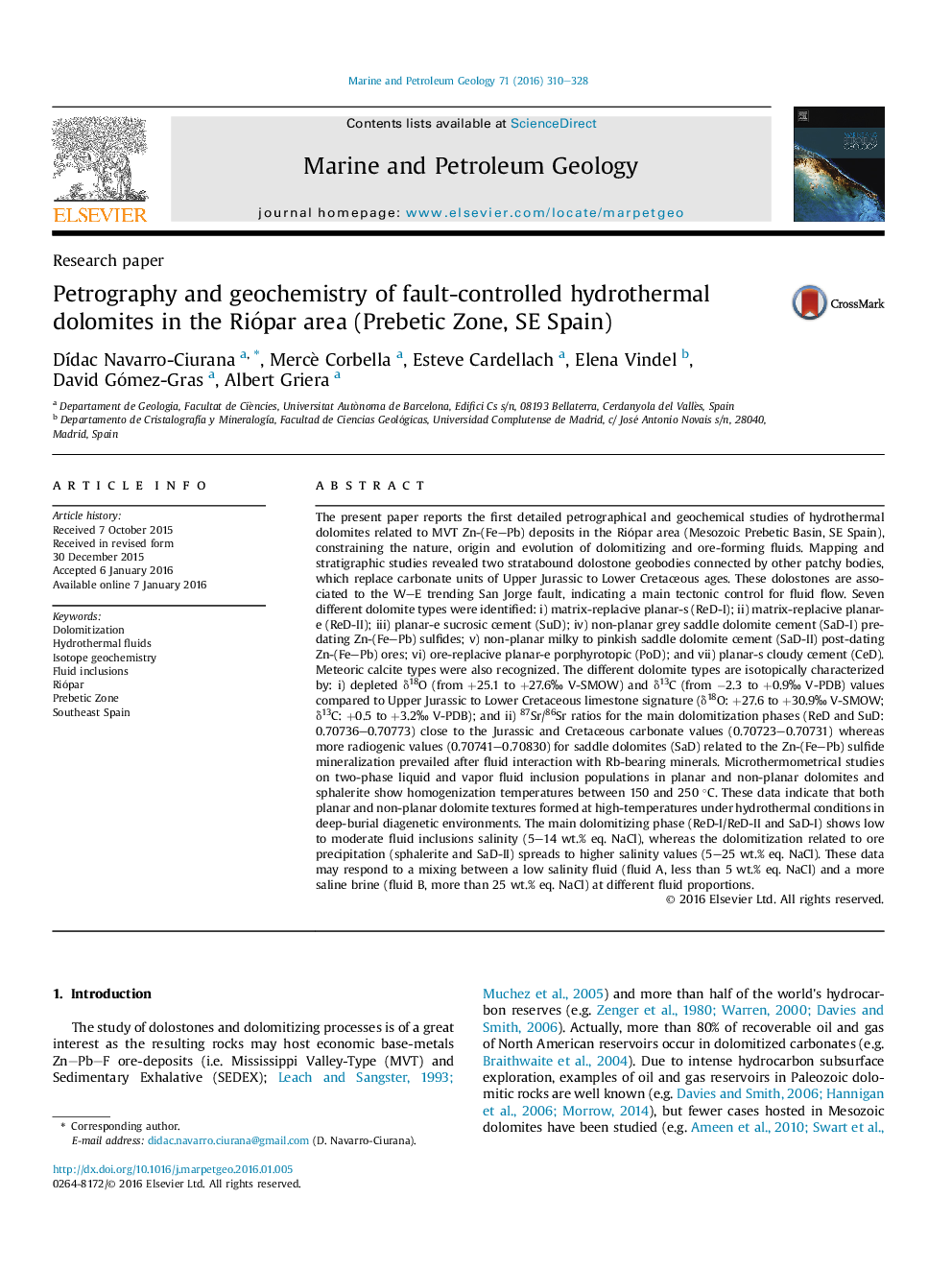| کد مقاله | کد نشریه | سال انتشار | مقاله انگلیسی | نسخه تمام متن |
|---|---|---|---|---|
| 4695433 | 1637156 | 2016 | 19 صفحه PDF | دانلود رایگان |

• The Riópar dolostones occur as stratabound and patchy geobodies hosted in Upper Jurassic to Lower Cretaceous carbonates.
• The dolomitization process is fault-controlled under hydrothermal conditions.
• Dolomite forms by mixing of different salinity but similar temperature fluids when faults tap different aquifers.
The present paper reports the first detailed petrographical and geochemical studies of hydrothermal dolomites related to MVT Zn-(Fe–Pb) deposits in the Riópar area (Mesozoic Prebetic Basin, SE Spain), constraining the nature, origin and evolution of dolomitizing and ore-forming fluids. Mapping and stratigraphic studies revealed two stratabound dolostone geobodies connected by other patchy bodies, which replace carbonate units of Upper Jurassic to Lower Cretaceous ages. These dolostones are associated to the W–E trending San Jorge fault, indicating a main tectonic control for fluid flow. Seven different dolomite types were identified: i) matrix-replacive planar-s (ReD-I); ii) matrix-replacive planar-e (ReD-II); iii) planar-e sucrosic cement (SuD); iv) non-planar grey saddle dolomite cement (SaD-I) pre-dating Zn-(Fe–Pb) sulfides; v) non-planar milky to pinkish saddle dolomite cement (SaD-II) post-dating Zn-(Fe–Pb) ores; vi) ore-replacive planar-e porphyrotopic (PoD); and vii) planar-s cloudy cement (CeD). Meteoric calcite types were also recognized. The different dolomite types are isotopically characterized by: i) depleted δ18O (from +25.1 to +27.6‰ V-SMOW) and δ13C (from −2.3 to +0.9‰ V-PDB) values compared to Upper Jurassic to Lower Cretaceous limestone signature (δ18O: +27.6 to +30.9‰ V-SMOW; δ13C: +0.5 to +3.2‰ V-PDB); and ii) 87Sr/86Sr ratios for the main dolomitization phases (ReD and SuD: 0.70736–0.70773) close to the Jurassic and Cretaceous carbonate values (0.70723–0.70731) whereas more radiogenic values (0.70741–0.70830) for saddle dolomites (SaD) related to the Zn-(Fe–Pb) sulfide mineralization prevailed after fluid interaction with Rb-bearing minerals. Microthermometrical studies on two-phase liquid and vapor fluid inclusion populations in planar and non-planar dolomites and sphalerite show homogenization temperatures between 150 and 250 °C. These data indicate that both planar and non-planar dolomite textures formed at high-temperatures under hydrothermal conditions in deep-burial diagenetic environments. The main dolomitizing phase (ReD-I/ReD-II and SaD-I) shows low to moderate fluid inclusions salinity (5–14 wt.% eq. NaCl), whereas the dolomitization related to ore precipitation (sphalerite and SaD-II) spreads to higher salinity values (5–25 wt.% eq. NaCl). These data may respond to a mixing between a low salinity fluid (fluid A, less than 5 wt.% eq. NaCl) and a more saline brine (fluid B, more than 25 wt.% eq. NaCl) at different fluid proportions.
Journal: Marine and Petroleum Geology - Volume 71, March 2016, Pages 310–328